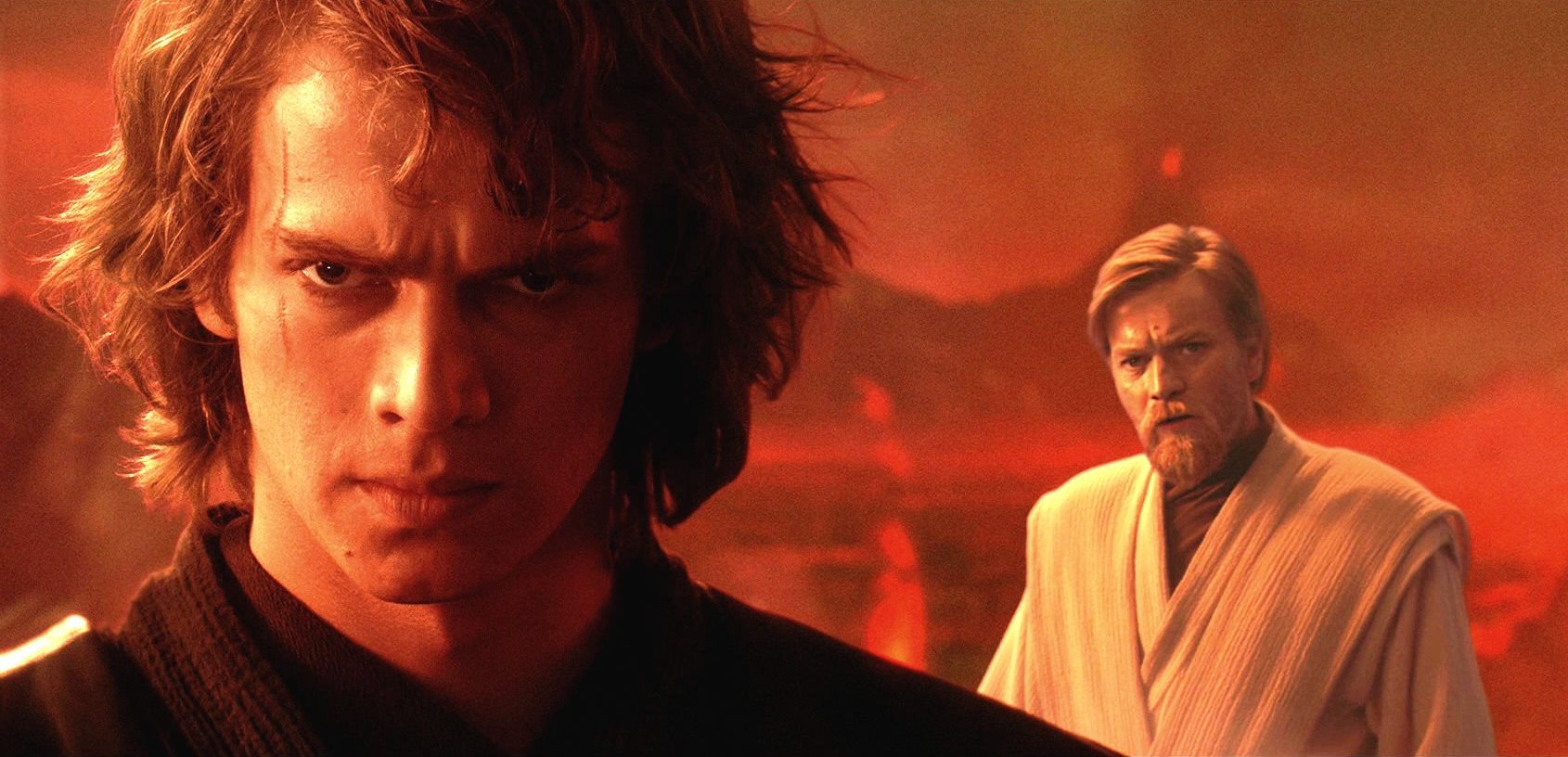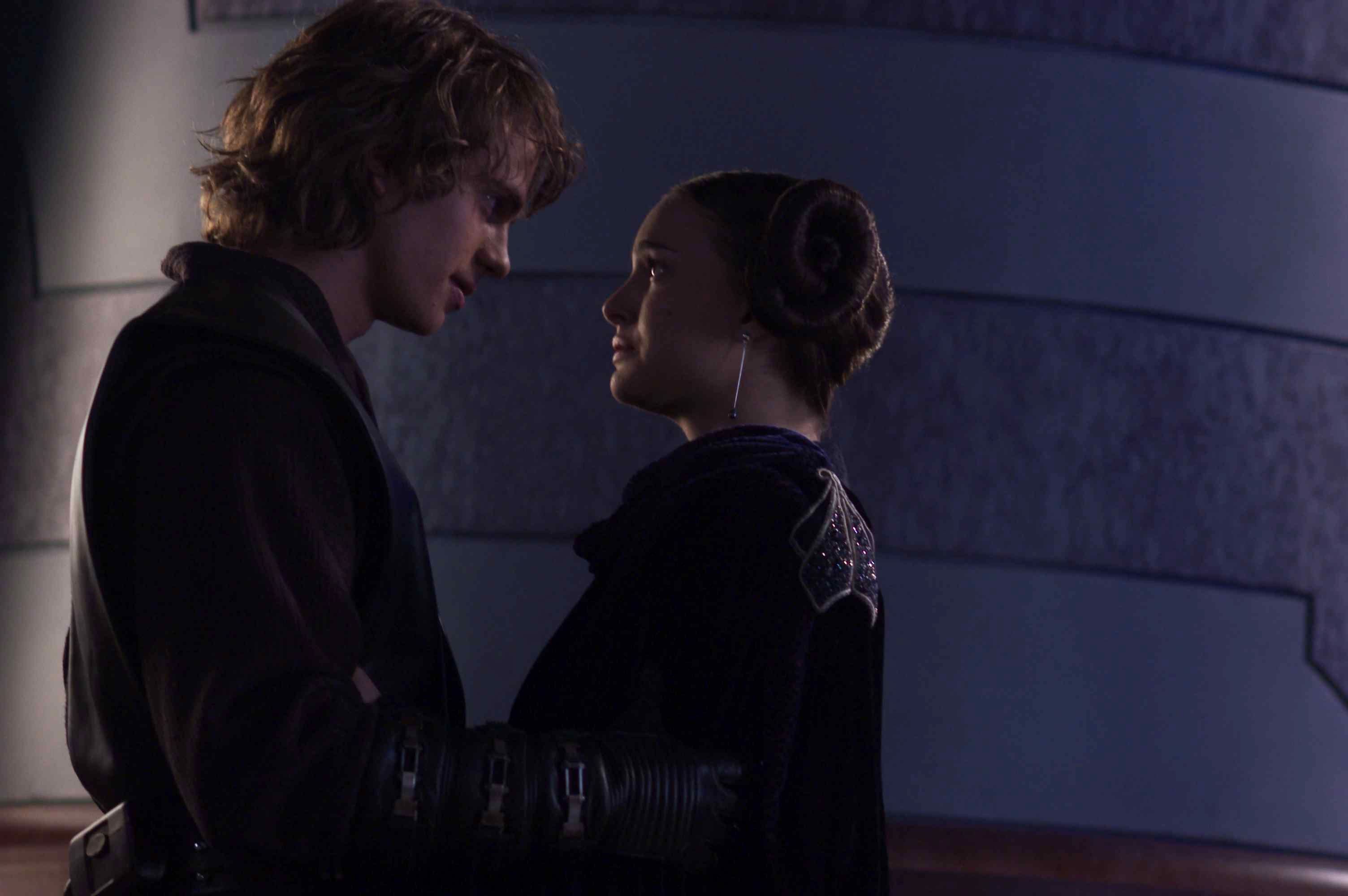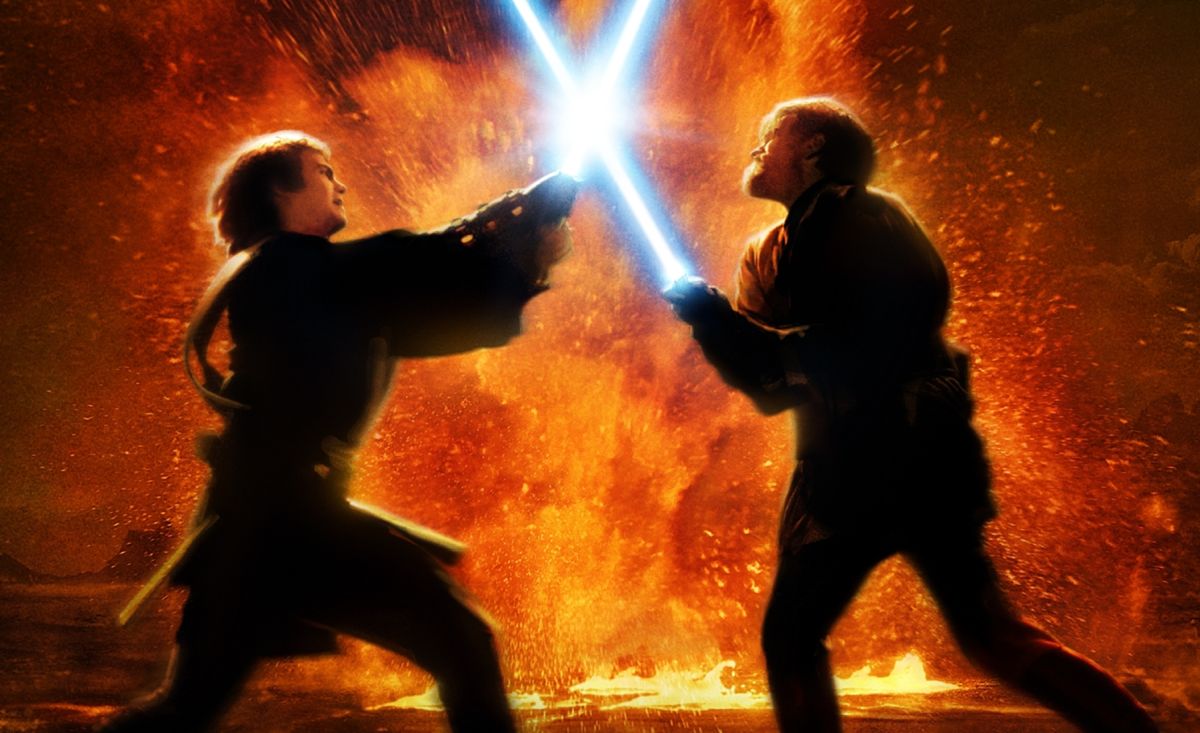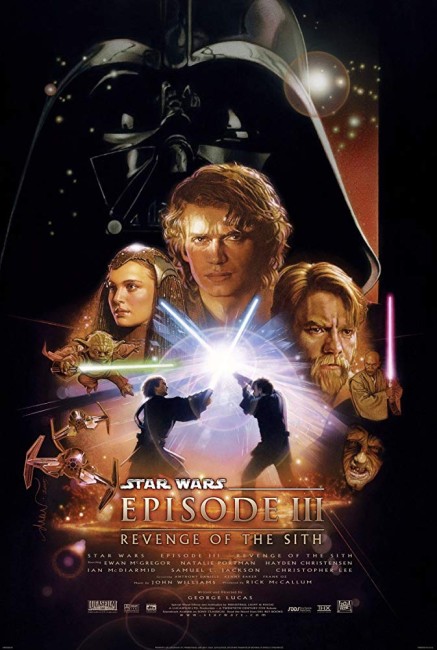Crew
Director/Screenplay – George Lucas, Producer – Rick McCallum, Photography – David Tattersall, Music – John Williams, Visual Effects Supervisors – Roger Guyett & John Knoll, Visual Effects – Industrial Light and Magic, Animation Director – Rob Coleman, Pre-Visualization Supervisor – Daniel D. Gregoire, Creature Supervisor – Dave Elsey, Special Effects Supervisor – David Young, Makeup Supervisor – Nikki Gooley, Production Design – Gavin Bocquet. Production Company – Lucasfilm/20th Century Fox.
Cast
Hayden Christensen (Anakin Skywalker/Darth Vader), Ewan McGregor (Obi-Wan Kenobi), Ian McDiarmid (Supreme Chancellor Palpatine), Natalie Portman (Padme Amidala), Frank Oz (Yoda), Samuel L. Jackson (Mace Windu), Anthony Daniels (C3PO), Kenny Baker (R2D2), Matthew Wood (Voice of General Grievous), Jimmy Smits (Senator Bail Organa), Christopher Lee (Count Dooku), Temuera Morrison (Commander Cody)
Plot
Obi-wan Keonbi and his apprentice Anakin Skywalker conduct a rescue of Chancellor Palpatine from in orbit around Coruscant after he is kidnapped by Count Dooku and the droid army led by General Grievous. Back home, Padme announces to Anakin that she is pregnant – however they dare not let their secret marriage be known by anyone else. Anakin then has a premonition of Padme’s death during childbirth. At the same time, Chancellor Palpatine insists that Anakin be made his personal representative on the Jedi Council. The Council grudgingly accept this request, although remain suspicious of Palpatine’s motives. Palpatine also tells Anakin that the Dark Side of the Force is not as bad as the Jedi make out and hints that it contains powers that can save Padme from her fate. He also plays on Anakin’s hotheadedness, twisting things around to suggest that the Jedi are conspiring against the Republic. He then reveals to Anakin that he is Darth Sidious, the Dark Lord of the Sith. When Anakin takes this news to the Jedi Council, they go to arrest Palpatine. Anakin is forced to make a choice and decides to side with Palpatine for the sake of Padme. With Anakin’s surrender to the Dark Side, Palpatine gives him the new name Darth Vader. Together they set out to eliminate the Jedi Knights and to transform the Republic into an empire with Palpatine as its Emperor.
For anybody who lives in Outer Mongolia or somewhere away from the spotlight of mass publicity, Revenge of the Sith was the third and last of the Star Wars prequels and what looked to be the very last of the (live-action) Star Wars films. Star Wars (1977), when it first appeared, was a phenomenon that swept the world to become the highest grossing box-office film of all time, produced countless imitators and inspired a special effects and screen science-fiction boom that continues to this day. At the point of his greatest success, George Lucas abruptly decided to retire and stepped back to a producing role. He heralded in Star Wars Episode V: The Empire Strikes Back (1980) and Star Wars Episode VI: Return of the Jedi (1983) under other directors and writers. Both were massively successful and Empire was greeted as even better than Star Wars by some fans. However, Return of the Jedi was also the point where the failings of the Star Wars series were starting to become apparent – in the slightness of story, a frequent indifference to the characters and an over-reliance on the special effects provided by Lucas’s Industrial Light and Magic facility.
However, after Return of the Jedi, George Lucas fell silent. There was an enormous degree of fan speculation about whether he would ever return to the series and what form the stories might take based on clues given in the existing films. As sixteen years dragged on, the original Star Wars fans began to lose hope that George Lucas would ever do so. That is until the late 1990s when Lucas suddenly announced he was going to return to the Star Wars saga once again with a series of prequels. However, when he finally did so with Star Wars Episode I: The Phantom Menace (1999), this proved, though a No. 1 box-office success, a disappointment to almost everybody who had waited the sixteen years between films. The subsequent prequel Star Wars Episode II: Attack of the Clones (2002) was regarded as marginally better but also a big disappointment.
The big question that loomed for many of the original Star Wars fans was – had George Lucas lost his mojo? Had he gone from boy wonder filled with fannish enthusiasm to someone merely making big screen Playstation games that were all special effects whiz and zip and almost no content in terms of story or character? Whatever the case, Revenge of the Sith was the last opportunity that George Lucas had to prove himself. Episodes I and II had been fairly much a write-off for all but the young. Certainly, of the fans I know, many had shrugged their shoulders by the time of Revenge of the Sith and lost the interest they once had.

The good news is that Revenge of the Sith is a welcome return to form where George Lucas shows that he still has the old mojo. The special effects are expectedly state of the art. There is a dazzling set-piece of a space battle in the skies above Coruscant that opens the film and ends with Anakin having to crashland a ship that is burning up and coming apart in re-entry. (Although, the scientific pedant in me kept quibbling and wanting to know why it was necessary for a ship to employ braking flaps in a void, or how it could burn up from re-entry friction before it is actually said to have entered the atmosphere). The background of every scene from the opening battle to the skies and cityscapes of Coruscant comes with an extraordinary degree of detail – the effects have almost reached a point where they could be considered a work of art in themselves. The design team let themselves completely go in coming up with a unique variety of new spaceships, droids, tanks, even monocycles – at times, the second trilogy seems to have been designed to show off as many new alien, vehicle and droid designs that the design team could come up with, limited only by being able to find an available inch of frame to squeeze them into.
The surprising thing about the effects is that, while completely dazzling, George Lucas has learned the lesson that they are not the most important thing about the film – as was the case with Return of the Jedi, Phantom Menace and Attack of the Clones. Revenge of the Sith welcomely puts them back in the service of story rather than construes the entire story around them. It is refreshing to see a Star Wars film that is once again dependent on drama. The opening scenes are good and there is an excellent sequence with Ewan McGregor taking on General Grievous who is armed with six lightsabres. However, it is the climactic battle between Anakin and Obi-wan Kenobi in and around a river of lava that is the breathtaking set-piece. It is this scene that is surely the single dramatic highlight of the prequels.
There is still the lurking feeling that George Lucas has to have something exciting and wondrous happening at all times and the climactic Obi-wan/Anakin duel is undercut with the need to also have a battle going on between Yoda and Chancellor Palpatine in the imperial debating chamber at the same time and the action flipping back and forward between the two. The story does not need the Yoda/Palpatine battle and one suspects that the Anakin/Obi-wan duel would have worked much better standing on its own. The measure of how much George Lucas has kept the effects in the service of drama is surely evidenced by the fact that the climactic resolution of the story is not any dazzling effects set-piece but something low-key effects-wise – the emergence of Darth Vader in his suit and the birth of the twins.

One of the weakest aspects of the prequels has been the cast and characters. Though George Lucas centres the trilogy around the character of Anakin Skywalker, Hayden Christensen is too wooden a choice of actor to carry such a key role. Christensen seems to only have a single expression – a brooding pout. One cannot help but think how much better the series would have been had there been an actor capable of more depth in the part. Natalie Portman is certainly an actress of some skill – see her work in Closer (2004), which had her nominated for a Best Supporting Actress Academy Award – but the character she plays in the prequels is flat and single dimensional. Here she gets the least to do of all the films and is literally consigned to being barefoot and pregnant. Ewan McGregor is another fine actor who has been stuck in a role that gives him little opportunity to flourish. (Plus, I keep finding it hard to believe that Ewan McGregor’s polite, obsequious Obi-wan would grow into the sagely Alec Guinness). What Revenge of the Sith (and the prequels) critically lack is actors like Harrison Ford, Carrie Fisher and Alec Guinness and to a lesser extent Mark Hamill, who seemed to inhabit, rather than simply perform their characters. You cannot say that that is something that Hayden Christensen, Natalie Portman or Ewan McGregor do.
That said, what makes Revenge of the Sith work is the fact that George Lucas has placed the emphasis back on story, character and drama. There is perhaps a little too much hopping from planet to planet to fully keep track of but the plot has a commendable depth and complexity. The dramatic centre of Revenge of the Sith is the moral conflicts within the soul of Anakin Skywalker. Perhaps Anakin’s choices are ultimately comic-bookish ones as George Lucas’s pop psychology take on characters goes but the character divide and in particular the scenes where we see Chancellor Palpatine seducing Anakin’s mind are excellent.
For fans, Revenge of the Sith holds the joy of seeing aspects of the later films all falling into place. We see Chancellor Palpatine change into the deformed and demoniac Emperor that we met in Return of the Jedi; the Republic becoming the Empire; the transformation of the clone army into the Stormtroopers; the twins Luke and Leia being born; and, of course, the moment where Anakin first stands up in the Darth Vader costume and those familiar basso asthmatic tones fill the theatre. There are nice little in-references – we see Darth Vader and the Emperor on the familiar bridge of one of his Star Destroyers viewing a skeletal Death Star; we visit the Wookie home planet – nice of George Lucas to tie in reference to the dread The Star Wars Holiday Special (1978) – and meet Chewbacca; we go on board Senator Organa’s ship, which is of course the same ship that Princess Leia escaped aboard in the opening scene of Star Wars. And the very last image is the lovely one of Owen and Beru standing against the multiple sunset on Tatooine – one of the iconic images of Star Wars – holding the infant Luke. It gives the series a wonderful sense of closure.

Ultimately, a number of questions linger. One cannot help but have the nagging suspicion that George Lucas’s idea of a nine-part saga may not have been much more than something that was written on the back of an envelope and/or that he was making much of it up on the fly. Some of the character connections between the two trilogies do not fit – why, after accepting Luke from Obi-wan Kenobi with such sentimental gratitude here, do Beru and Lars seem so hostile to Kenobi and opposed to Luke having anything to do with him by the time of Star Wars? Why does Vader not recognise the family connections when he tortures Princess Leia in Star Wars – he is able to recognise Luke in Empire, after all? Why do the Jedi employ the clone army here and in Attack of the Clones without any suspicions about doing so when there seems ample evidence that they should be leery?
More importantly, it seems hard to connect up the character of Anakin here with the Darth Vader that we saw in the first trilogy, who seems magisterial in his evil, not a hot-headed teenager with authority and impulse-control problems. Anakin seems to perpetually act without ever thinking about consequences. It seems difficult to think of the Darth Vader of the original trilogy acting like that, let alone being someone whose choice in life all resulted simply because he wanted to save the love of his life.
Around the same time, there was also Star Wars: Clone Wars (2003-5), a series of five-minute animated episodes that aired on the Cartoon Network. This was later extended as an animated film Star Wars: The Clone Wars (2008), which was the flagship for an animated tv series Star Wars: The Clone Wars (2008-14). Chronologically, the events of these would appear to happen between Attack of the Clones and Revenge of the Sith. In 2012, George Lucas sold Lucasfilm to Disney who produced a new trilogy of films with Star Wars Episode VII: The Force Awakens (2015), Star Wars Episode VIII: The Last Jedi (2017) and Star Wars Episode IX: Rise of the Skywalker (2019). Disney also created a series of live-action spinoff films with Rogue One (2016) and Solo: A Star Wars Story (2018), plus the tv series’ The Mandalorian (2019- ), The Book of Boba Fett (2021-2), Andor (2022- ), Obi-wan Kenobi (2022), Ahsoka (2023- ) and The Acolyte (2024).
(Nominee for Best Special Effects at this site’s Best of 2005 Awards).


